12. A Simple Neural Network from Scratch in Python
By Bernd Klein. Last modified: 19 Apr 2024.
Linearly Separable Data Sets
As we have shown in the previous chapter of our tutorial on machine learning, a neural network consisting of only one perceptron was enough to separate our example classes. Of course, we carefully designed these classes to make it work. There are many clusters of classes, for whichit will not work. We are going to have a look at some other examples and will discuss cases where it will not be possible to separate the classes.
Our classes have been linearly separable. Linear separability make sense in Euclidean geometry. Two sets of points (or classes) are called linearly separable, if at least one straight line in the plane exists so that all the points of one class are on one side of the line and all the points of the other class are on the other side.
More formally:
If two data clusters (classes) can be separated by a decision boundary in the form of a linear equation
they are called linearly separable.
Otherwise, i.e. if such a decision boundary does not exist, the two classes are called linearly inseparable. In this case, we cannot use a simple neural network.
Live Python training
See our Python training courses
Perceptron for the AND Function
In our next example we will program a Neural Network in Python which implements the logical "And" function. It is defined for two inputs in the following way:
| Input1 | Input2 | Output |
|---|---|---|
| 0 | 0 | 0 |
| 0 | 1 | 0 |
| 1 | 0 | 0 |
| 1 | 1 | 1 |
We learned in the previous chapter that a neural network with one perceptron and two input values can be interpreted as a decision boundary, i.e. straight line dividing two classes. The two classes we want to classify in our example look like this:
import matplotlib.pyplot as plt
import numpy as np
fig, ax = plt.subplots()
xmin, xmax = -0.2, 1.4
X = np.arange(xmin, xmax, 0.1)
ax.scatter(0, 0, color="r")
ax.scatter(0, 1, color="r")
ax.scatter(1, 0, color="r")
ax.scatter(1, 1, color="g")
ax.set_xlim([xmin, xmax])
ax.set_ylim([-0.1, 1.1])
m = -1
#ax.plot(X, m * X + 1.2, label="decision boundary")
plt.plot()
OUTPUT:
[]
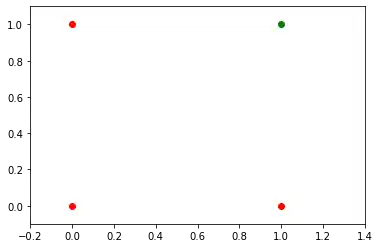
We also found out that such a primitive neural network is only capable of creating straight lines going through the origin. So dividing lines like this:
import matplotlib.pyplot as plt
import numpy as np
fig, ax = plt.subplots()
xmin, xmax = -0.2, 1.4
X = np.arange(xmin, xmax, 0.1)
ax.set_xlim([xmin, xmax])
ax.set_ylim([-0.1, 1.1])
m = -1
for m in np.arange(0, 6, 0.1):
ax.plot(X, m * X )
ax.scatter(0, 0, color="r")
ax.scatter(0, 1, color="r")
ax.scatter(1, 0, color="r")
ax.scatter(1, 1, color="g")
plt.plot()
OUTPUT:
[]
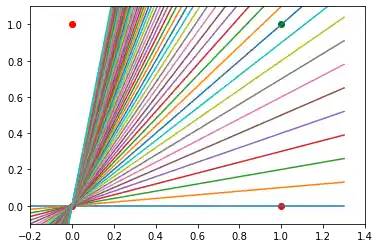
We can see that none of these straight lines can be used as decision boundary nor any other lines going through the origin.
We need a line
where the intercept c is not equal to 0.
For example the line
could be used as a separating line for our problem:
import matplotlib.pyplot as plt
import numpy as np
fig, ax = plt.subplots()
xmin, xmax = -0.2, 1.4
X = np.arange(xmin, xmax, 0.1)
ax.scatter(0, 0, color="r")
ax.scatter(0, 1, color="r")
ax.scatter(1, 0, color="r")
ax.scatter(1, 1, color="g")
ax.set_xlim([xmin, xmax])
ax.set_ylim([-0.1, 1.1])
m, c = -1, 1.2
ax.plot(X, m * X + c )
plt.plot()
OUTPUT:
[]
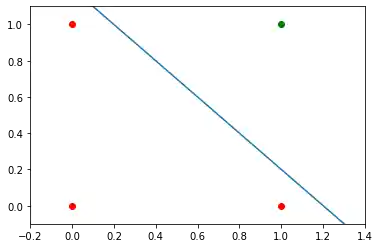
The question now is whether we can find a solution with minor modifications of our network model? Or in other words: Can we create a perceptron capable of defining arbitrary decision boundaries?
The solution consists in the addition of a bias node.
Single Perceptron with a Bias
A perceptron with two input values and a bias corresponds to a general straight line. With the aid of the bias value b we can train the perceptron to determine a decision boundary with a non zero intercept c.
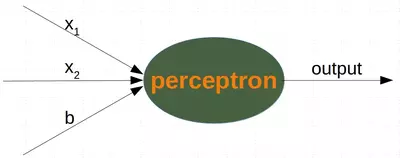
While the input values can change, a bias value always remains constant. Only the weight of the bias node can be adapted.
Now, the linear equation for a perceptron contains a bias:
In our case it looks like this:
this is equivalent with
This means:
and
%%capture
%%writefile perceptrons.py
import numpy as np
from collections import Counter
class Perceptron:
def __init__(self,
weights,
bias=1,
learning_rate=0.3):
"""
'weights' can be a numpy array, list or a tuple with the
actual values of the weights. The number of input values
is indirectly defined by the length of 'weights'
"""
self.weights = np.array(weights)
self.bias = bias
self.learning_rate = learning_rate
@staticmethod
def unit_step_function(x):
if x <= 0:
return 0
else:
return 1
def __call__(self, in_data):
"""
Perform forward pass through the perceptron.
"""
in_data = np.concatenate( (in_data, [self.bias]) )
result = self.weights @ in_data
return Perceptron.unit_step_function(result)
def adjust(self,
target_result,
in_data):
"""
Adjust weights based on error.
Args:
target_result: Target output.
in_data: Input data.
"""
in_data = np.array(in_data)
calculated_result = self(in_data)
error = target_result - calculated_result
if error != 0:
in_data = np.concatenate( (in_data, [self.bias]) )
correction = error * in_data * self.learning_rate
self.weights += correction
def evaluate(self, data, labels):
"""
Evaluate the perceptron on a dataset.
Args:
data: List of input data arrays.
labels: List of corresponding labels (0 or 1).
Returns:
Counter object containing evaluation results.
"""
evaluation = Counter()
for sample, label in zip(data, labels):
result = self(sample) # predict
if result == label:
evaluation["correct"] += 1
else:
evaluation["wrong"] += 1
return evaluation
We assume that the above Python code with the Perceptron class is stored in your current working directory under the name 'perceptrons.py'.
import numpy as np
from perceptrons import Perceptron
def labelled_samples(n):
for _ in range(n):
s = np.random.randint(0, 2, (2,))
yield (s, 1) if s[0] == 1 and s[1] == 1 else (s, 0)
p = Perceptron(weights=[0.3, 0.3, 0.3],
learning_rate=0.2)
for in_data, label in labelled_samples(30):
p.adjust(label,
in_data)
test_data, test_labels = list(zip(*labelled_samples(30)))
evaluation = p.evaluate(test_data, test_labels)
print(evaluation)
OUTPUT:
Counter({'correct': 30})
import matplotlib.pyplot as plt
import numpy as np
fig, ax = plt.subplots()
xmin, xmax = -0.2, 1.4
X = np.arange(xmin, xmax, 0.1)
ax.scatter(0, 0, color="r")
ax.scatter(0, 1, color="r")
ax.scatter(1, 0, color="r")
ax.scatter(1, 1, color="g")
ax.set_xlim([xmin, xmax])
ax.set_ylim([-0.1, 1.1])
m = -p.weights[0] / p.weights[1]
c = -p.weights[2] / p.weights[1]
print(m, c)
ax.plot(X, m * X + c )
plt.plot()
OUTPUT:
-3.0000000000000004 3.0000000000000013
[]
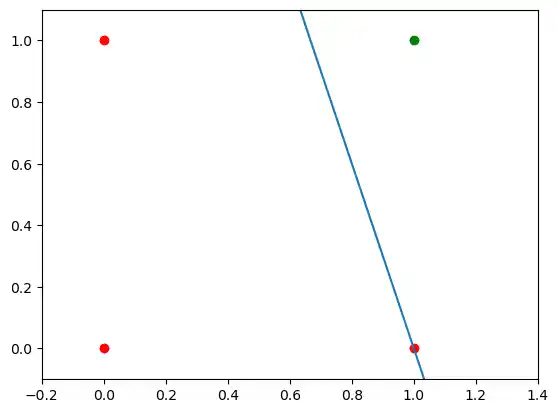
We will create another example with linearly separable data sets, which need a bias node to be separable. We will use the make_blobs function from sklearn.datasets:
from sklearn.datasets import make_blobs
n_samples = 1000
samples, labels = make_blobs(n_samples=n_samples,
centers=([2.5, 3], [6.7, 7.9]),
cluster_std=1.4,
random_state=0)
Let us visualize the previously created data:
import matplotlib.pyplot as plt
colours = ('green', 'magenta', 'blue', 'cyan', 'yellow', 'red')
fig, ax = plt.subplots()
for n_class in range(2):
ax.scatter(samples[labels==n_class][:, 0], samples[labels==n_class][:, 1],
c=colours[n_class], s=40, label=str(n_class))
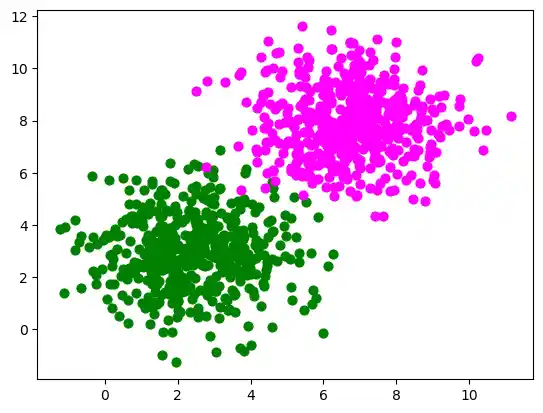
from sklearn.model_selection import train_test_split
res = train_test_split(samples, labels,
train_size=0.8,
test_size=0.2,
random_state=1)
train_data, test_data, train_labels, test_labels = res
from perceptrons import Perceptron
p = Perceptron(weights=[0.3, 0.3, 0.3],
learning_rate=0.8)
for sample, label in zip(train_data, train_labels):
p.adjust(label,
sample)
evaluation = p.evaluate(train_data, train_labels)
print(evaluation)
OUTPUT:
Counter({'correct': 784, 'wrong': 16})
evaluation = p.evaluate(test_data, test_labels)
print(evaluation)
OUTPUT:
Counter({'correct': 194, 'wrong': 6})
Let us visualize the decision boundary:
import matplotlib.pyplot as plt
fig, ax = plt.subplots()
# plotting learn data
colours = ('green', 'blue')
for n_class in range(2):
ax.scatter(train_data[train_labels==n_class][:, 0],
train_data[train_labels==n_class][:, 1],
c=colours[n_class], s=40, label=str(n_class))
# plotting test data
colours = ('lightgreen', 'lightblue')
for n_class in range(2):
ax.scatter(test_data[test_labels==n_class][:, 0],
test_data[test_labels==n_class][:, 1],
c=colours[n_class], s=40, label=str(n_class))
X = np.arange(np.max(samples[:,0]))
m = -p.weights[0] / p.weights[1]
c = -p.weights[2] / p.weights[1]
print(m, c)
ax.plot(X, m * X + c )
plt.plot()
plt.show()
OUTPUT:
-1.4277135509226737 10.516023065099064
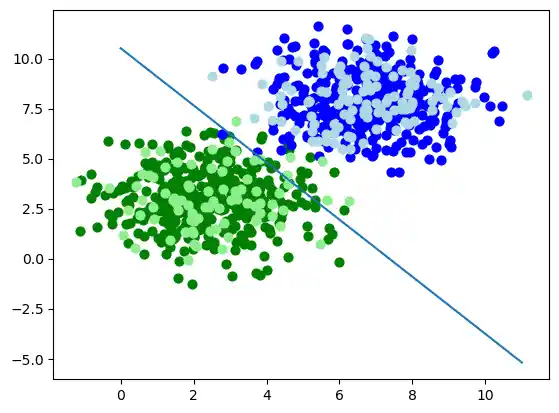
In the following section, we will introduce the XOR problem for neural networks. It is the simplest example of a non linearly separable neural network. It can be solved with an additional layer of neurons, which is called a hidden layer.
The XOR Problem for Neural Networks
The XOR (exclusive or) function is defined by the following truth table:
| Input1 | Input2 | XOR Output |
|---|---|---|
| 0 | 0 | 0 |
| 0 | 1 | 1 |
| 1 | 0 | 1 |
| 1 | 1 | 0 |
This problem can't be solved with a simple neural network, as we can see in the following diagram:
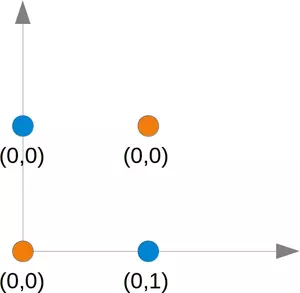
No matter which straight line you choose, you will never succeed in having the blue points on one side and the orange points on the other side. This is shown in the following figure. The orange points are on the orange line. This means that this cannot be a dividing line. If we move this line parallel - no matter which direction, there will be always two orange and one blue point on one side and only one blue point on the other side. If we move the orange line in a non parallel way, there will be one blue and one orange point on either side, except if the line goes through an orange point. So there is no way for a single straight line separating those points.
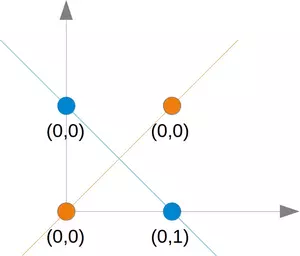
To solve this problem, we need to introduce a new type of neural networks, a network with so-called hidden layers. A hidden layer allows the network to reorganize or rearrange the input data.
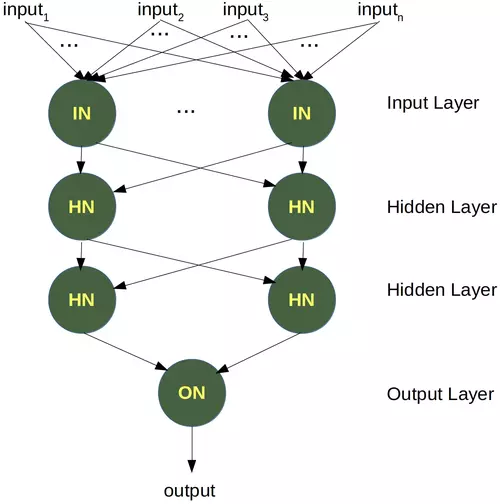
We will need only one hidden layer with two neurons. One works like an AND gate and the other one like an OR gate. The output will "fire", when the OR gate fires and the AND gate doesn't.
As we had already mentioned, we cannot find a line which separates the orange points from the blue points. But they can be separated by two lines, e.g. L1 and L2 in the following diagram:
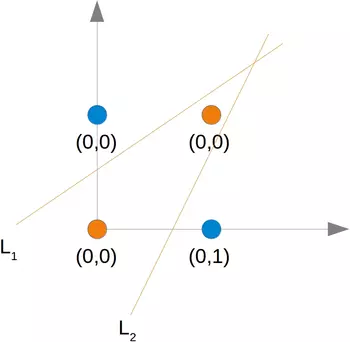
To solve this problem, we need a network of the following kind, i.e with a hidden layer N1 and N2
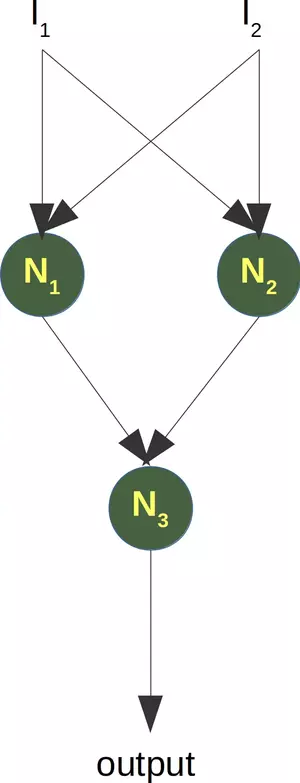
The neuron N1 will determine one line, e.g. L1 and the neuron N2 will determine the other line L2. N3 will finally solve our problem:
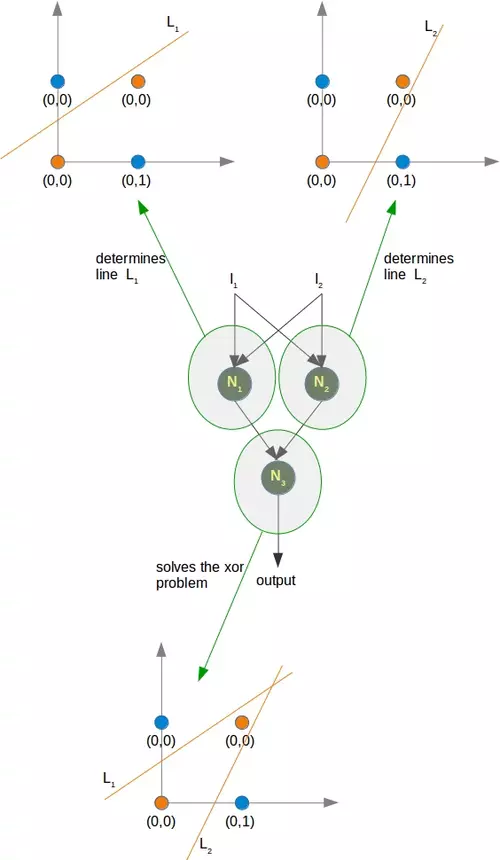
The implementation of this in Python has to wait until the next chapter of our tutorial on machine learning.
Live Python training
Upcoming online Courses
Efficient Data Analysis with Pandas
01 Dec to 02 Dec 2025
Python and Machine Learning Course
01 Dec to 05 Dec 2025
Machine Learning from Data Preparation to Deep Learning
01 Dec to 05 Dec 2025
See our Python training courses
Exercises
Exercise 1
We could extend the logical AND to float values between 0 and 1 in the following way:
| Input1 | Input2 | Output |
|---|---|---|
| x1 < 0.5 | x2 < 0.5 | 0 |
| x1 < 0.5 | x2 >= 0.5 | 0 |
| x1 >= 0.5 | x2 < 0.5 | 0 |
| x1 >= 0.5 | x2 >= 0.5 | 1 |
Try to train a neural network with only one perceptron. Why doesn't it work?
Exercise 2
A point belongs to a class 0, if $x_1 < 0.5$ and belongs to class 1, if $x_1 >= 0.5$. Train a network with one perceptron to classify arbitrary points. What can you say about the dicision boundary? What about the input values $x_2$
Solutions to the exercises
Solution to the 1. Exercise
from perceptrons import Perceptron
p = Perceptron(weights=[0.3, 0.3, 0.3],
bias=1,
learning_rate=0.2)
def labelled_samples(n):
for _ in range(n):
s = np.random.random((2,))
yield (s, 1) if s[0] >= 0.5 and s[1] >= 0.5 else (s, 0)
for in_data, label in labelled_samples(30):
p.adjust(label,
in_data)
test_data, test_labels = list(zip(*labelled_samples(60)))
evaluation = p.evaluate(test_data, test_labels)
print(evaluation)
OUTPUT:
Counter({'correct': 48, 'wrong': 12})
The easiest way to see, why it doesn't work, is to visualize the data.
import matplotlib.pyplot as plt
import numpy as np
ones = [test_data[i] for i in range(len(test_data)) if test_labels[i] == 1]
zeroes = [test_data[i] for i in range(len(test_data)) if test_labels[i] == 0]
fig, ax = plt.subplots()
xmin, xmax = -0.2, 1.2
X, Y = list(zip(*ones))
ax.scatter(X, Y, color="g")
X, Y = list(zip(*zeroes))
ax.scatter(X, Y, color="r")
ax.set_xlim([xmin, xmax])
ax.set_ylim([-0.1, 1.1])
c = -p.weights[2] / p.weights[1]
m = -p.weights[0] / p.weights[1]
X = np.arange(xmin, xmax, 0.1)
ax.plot(X, m * X + c, label="decision boundary")
OUTPUT:
[<matplotlib.lines.Line2D at 0x7fc386f20c10>]
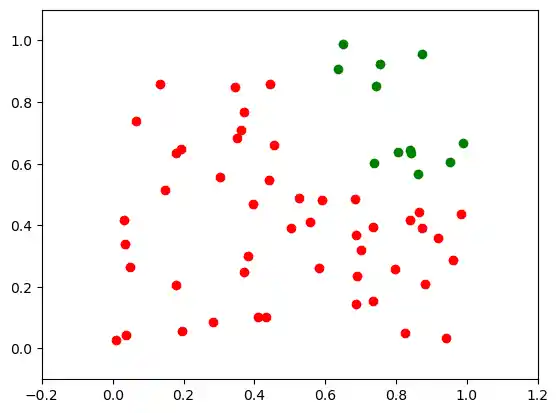
We can see that the green points and the red points are not separable by one straight line.
Solution to the 2nd Exercise
from perceptrons import Perceptron
import numpy as np
from collections import Counter
def labelled_samples(n):
for _ in range(n):
s = np.random.random((2,))
yield (s, 0) if s[0] < 0.5 else (s, 1)
p = Perceptron(weights=[0.3, 0.3, 0.3],
learning_rate=0.4)
for in_data, label in labelled_samples(300):
p.adjust(label,
in_data)
test_data, test_labels = list(zip(*labelled_samples(500)))
print(p.weights)
p.evaluate(test_data, test_labels)
OUTPUT:
[ 1.8816968 0.02059955 -0.9 ]
Counter({'correct': 489, 'wrong': 11})
import matplotlib.pyplot as plt
import numpy as np
ones = [test_data[i] for i in range(len(test_data)) if test_labels[i] == 1]
zeroes = [test_data[i] for i in range(len(test_data)) if test_labels[i] == 0]
fig, ax = plt.subplots()
xmin, xmax = -0.2, 1.2
X, Y = list(zip(*ones))
ax.scatter(X, Y, color="g")
X, Y = list(zip(*zeroes))
ax.scatter(X, Y, color="r")
ax.set_xlim([xmin, xmax])
ax.set_ylim([-0.1, 1.1])
c = -p.weights[2] / p.weights[1]
m = -p.weights[0] / p.weights[1]
X = np.arange(xmin, xmax, 0.1)
ax.plot(X, m * X + c, label="decision boundary")
OUTPUT:
[<matplotlib.lines.Line2D at 0x7fc386f2e650>]
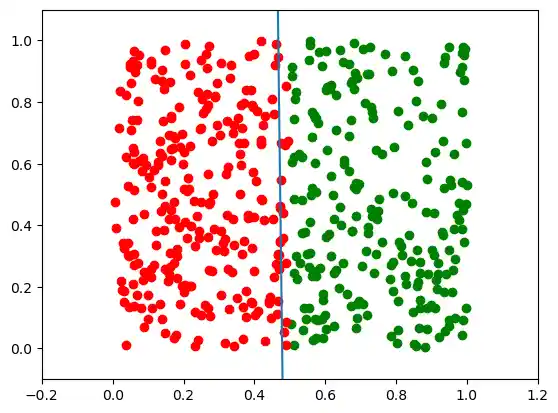
p.weights, m
OUTPUT:
(array([ 1.8816968 , 0.02059955, -0.9 ]), -91.34649302039234)
The slope m will have to get larger and larger in situations like this.
Live Python training
Upcoming online Courses
Efficient Data Analysis with Pandas
01 Dec to 02 Dec 2025
Python and Machine Learning Course
01 Dec to 05 Dec 2025
Machine Learning from Data Preparation to Deep Learning
01 Dec to 05 Dec 2025
See our Python training courses
